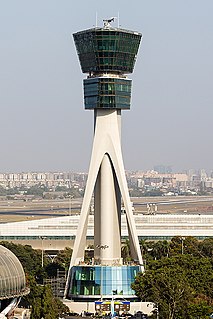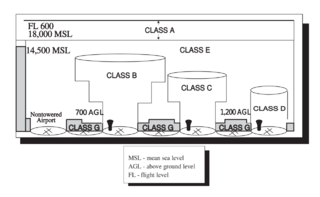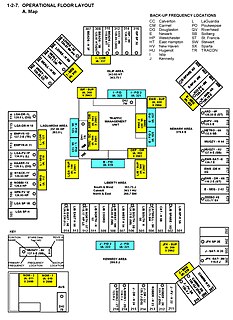
Air traffic control (ATC) is a service provided by ground-based air traffic controllers who direct aircraft on the ground and through a given section of controlled airspace, and can provide advisory services to aircraft in non-controlled airspace. The primary purpose of ATC worldwide is to prevent collisions, organize and expedite the flow of air traffic, and provide information and other support for pilots. In some countries, ATC plays a security or defensive role, or is operated by the military.

Boise Airport is a joint civil-military airport in the western United States, three miles (5 km) south of downtown Boise in Ada County, Idaho. The airport is operated by the city of Boise Department of Aviation and is overseen by an airport commission. It is the busiest airport in the state of Idaho, serving more passengers than all other Idaho airports combined and roughly ten times as many passengers as Idaho's second busiest airport, Idaho Falls Regional Airport.

Kalamazoo/Battle Creek International Airport is a county-owned public airport 3 miles (4.8 km) southeast of Kalamazoo, in Kalamazoo County, Michigan, USA. The airport is located approximately 20 miles (32 km) west of the city of Battle Creek. It is included in the Federal Aviation Administration (FAA) National Plan of Integrated Airport Systems for 2017–2021, in which it is categorized as a non-hub primary commercial service facility.

In air traffic control, an area control center (ACC), also known as a center or en-route center, is a facility responsible for controlling aircraft flying in the airspace of a given flight information region (FIR) at high altitudes between airport approaches and departures. In the US, such a center is referred to as an air route traffic control center (ARTCC).

Trans World Airlines (TWA) Flight 553 was a McDonnell Douglas DC-9-15 jet airliner, registration N1063T, operated by Trans World Airlines on March 9, 1967 between Pittsburgh, Pennsylvania and Dayton, Ohio. While descending toward Dayton about 29 miles from the airport, the flight collided in midair with a Beechcraft Baron, a small, general-aviation airplane, near Urbana, Ohio. All 25 aboard the DC-9 and the sole occupant of the Beechcraft were killed.

An airport surveillance radar (ASR) is a radar system used at airports to detect and display the presence and position of aircraft in the terminal area, the airspace around airports. It is the main air traffic control system for the airspace around airports. At large airports it typically controls traffic within a radius of 60 miles (96 km) of the airport below an elevation of 25,000 feet. The sophisticated systems at large airports consist of two different radar systems, the primary and secondary surveillance radar. The primary radar typically consists of a large rotating parabolic antenna dish that sweeps a vertical fan-shaped beam of microwaves around the airspace surrounding the airport. It detects the position and range of aircraft by microwaves reflected back to the antenna from the aircraft's surface. The secondary surveillance radar consists of a second rotating antenna, often mounted on the primary antenna, which interrogates the transponders of aircraft, which transmits a radio signal back containing the aircraft's identification, barometric altitude, and an emergency status code, which is displayed on the radar screen next to the return from the primary radar.

The United States airspace system's classification scheme is intended to maximize pilot flexibility within acceptable levels of risk appropriate to the type of operation and traffic density within that class of airspace – in particular to provide separation and active control in areas of dense or high-speed flight operations.
The London Terminal Control Centre (LTCC) was an air traffic control centre based in West Drayton, in the London Borough of Hillingdon, England, approximately 2.5 miles (4.0 km) north of London Heathrow airport. Operated by National Air Traffic Services (NATS) it provided air traffic control services to aircraft arriving and departing from six London airports, one Royal Air Force station, plus en-route services to other aircraft that entered its airspace. Internally within NATS it is usually known by the initials TC. The civilian part of the West Drayton site closed in November 2007, when its functions moved to Swanwick, Hampshire. 'TC' and 'AC' remain separate organisations but now share the same site.
Boston Air Route Traffic Control Center is one of 22 Air Route Traffic Control Centers in the United States, located in Nashua, New Hampshire.

The New York Terminal Radar Approach Control (TRACON) is located in Westbury, Long Island. New York TRACON, also known as N90, is a type of Federal Aviation Administration air traffic control facility known as a consolidated TRACON, meaning that a single location provides approach service for several large airports. The primary responsibility of the New York TRACON is the safe, orderly, and expeditious flow of arrival, departure, and en-route traffic. N90 is responsible for three major airports, all located within the same New York Class B airspace: John F. Kennedy International Airport, Newark Liberty International Airport, and LaGuardia Airport. Additionally, N90 is responsible for dozens of smaller but busy fields, including Long Island MacArthur Airport, Teterboro Airport, Tweed New Haven Regional Airport, and Republic Airport. N90 also controls the large number of VFR aircraft that fly through the New York Class B airspace every day.
The Philadelphia TRACON/ATCT is located at the Philadelphia International Airport and is a TRACON with Up-and-Down capabilities which means it includes both a TRACON and ATCT in the same facility. The facility is "sectorized" into two sectors for the controllers. "A-side" controllers, work the tower, and half the radar room. "B-side" controllers work the entire radar room (POM).

The Boston Consolidated TRACON (A90) is located in Merrimack, New Hampshire. A90 opened in 2004 after 8 years of development. The A90 function transferred to the new Boston Consolidated TRACON on February 22, 2004. The MHT function transferred over on March 7, 2004. Manchester TRACON used to be located at Manchester Airport below the old ATCT. Boston TRACON used to be located at the Logan International Airport Control Tower before being consolidated. The new facility is 63,000 square feet (5,900 m2). A Terminal Radar Approach Control, or TRACON, is responsible for descending airplanes from the ARTCC and lining them up for landing at their destination airport, as well as climbing departures before handing off to the ARTCC.
The National Airspace System (NAS) is the airspace, navigation facilities and airports of the United States along with their associated information, services, rules, regulations, policies, procedures, personnel and equipment. It includes components shared jointly with the military. It is one of the most complex aviation systems in the world, and services air travel in the United States and over large portions of the world's oceans.

The Air Traffic Organization (ATO) is an air navigation service provider in the United States of America. The ATO is the operational division of the Federal Aviation Administration (FAA).

Anchorage Air Route Traffic Control Center (PAZA/ZAN) is located just outside the main gate of Joint Base Elmendorf-Richardson at 700 North Boniface Parkway in Anchorage, Alaska, United States. The Anchorage ARTCC is one of 22 Air Route Traffic Control Centers in the United States.

Potomac TRACON , abbreviated PCT, is the FAA air traffic control facility in charge of the Washington, D.C. airspace and Washington Special Flight Rules Area, assigning squawk codes. It is based in Warrenton, Virginia, United States.
Northern California TRACON (NCT), or NorCal TRACON for short, is an air traffic control facility that provides safety alerts, separation, and sequencing of air traffic arriving, departing, and transiting the airspace and airports in Northern California, United States. Located in Mather about 10 miles east of downtown Sacramento, NCT controls airspace over 19,000 square miles (49,000 km2), and serves Reno International Airport, Sacramento International Airport, San Jose International Airport, Oakland International Airport, and San Francisco International Airport, plus 19 other smaller airports with airport traffic control towers. NCT is the 3rd busiest TRACON in the US. NorCal TRACON is the step between local control and an Air Route Traffic Control Center (ARTCC), in this case, Oakland Center. San Francisco International Airport is the 2nd largest airport in California and the largest airport serving Northern California.

The New York metropolitan area has the busiest airport system in the United States and the second busiest in the world after London. It is also the most frequently used port of entry and departure for international flights. In 2011, more than 104 million passengers used the airports under the auspices of the Port Authority of New York and New Jersey (PANYNJ). The number increased to 117 million in 2014.
The 2014 Chicago Air Route Traffic Control Center fire was an incident in the United States where arson at an air traffic control facility in Aurora, Illinois caused close to 2000 airline flights to be grounded. One employee at the facility was treated for smoke inhalation, while 15 to 30 employees were evacuated.
The Cape TRACON (K90) is a radar approach facility located at Joint Base Cape Cod, Massachusetts next to the airfield for Coast Guard Air Station Cape Cod. It is operated by the Federal Aviation Administration (FAA).












